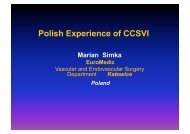ISNVD Abstract Book
ISNVD Abstract Book
ISNVD Abstract Book
Create successful ePaper yourself
Turn your PDF publications into a flip-book with our unique Google optimized e-Paper software.
Azygos compression and effect of respiratory cycle during CCSVI venography.<br />
Michael Arata Andrew, MD<br />
OBJECTIVE. Chronic Cerebrospinal Venous Insufficiency (CCSVI) is venous<br />
hypertension of the cerebrospinal veins resulting from a flow obstructing lesion in the<br />
jugular and azygos veins. It is most often are result of venous valve malfunction.<br />
Extrinsic venous compression in these veins may also result in flow obstruction. It has<br />
been suggested that the compression of the azygous vein is a result of respiratory<br />
motion rather than a fixed lesion. We retrospectively reviewed the azygous venographic<br />
images obtained during the CCSVI procedure. Azygos venogram technique included<br />
imaging at full inspiration and after complete exhalation. Evaluation of the relative<br />
frequency of azygos vein compression during CCSVI venogram and the effect of<br />
respiratory motion on the degree of compression was undertaken.<br />
MATERIALS AND METHODS. A database search was performed of all CCSVI<br />
procedures performed over a two month period starting July 2011. Review of the<br />
azygos portion of these venograms was undertaken. Determination of the presence of<br />
significant stenosis, defined as 50% or greater was performed. If a significant stenosis<br />
was present the lesion was compared to assess for change associated with respiration.<br />
RESULTS. Over the two month study period, 54 CCSVI procedures were performed<br />
and had azygous imaging performed with full inspiration and complete expiration.<br />
Compression resulting in significant stenosis was identified in 26% (n=14). The<br />
significant stenosis was only present at complete exhalation in 19% (n=10). Stenoses<br />
of greater than 70% did not change with respiration (n=4).<br />
CONCLUSION. Venous compression of the azygos vein can produce flow obstructing<br />
lesions in up to 1/4 of patients. Imaging at full inspiration is helpful to identify fixed flow<br />
limiting lesions. Fixed lesions that do not change with respiration tend to be of a more<br />
significant degree of stenosis




